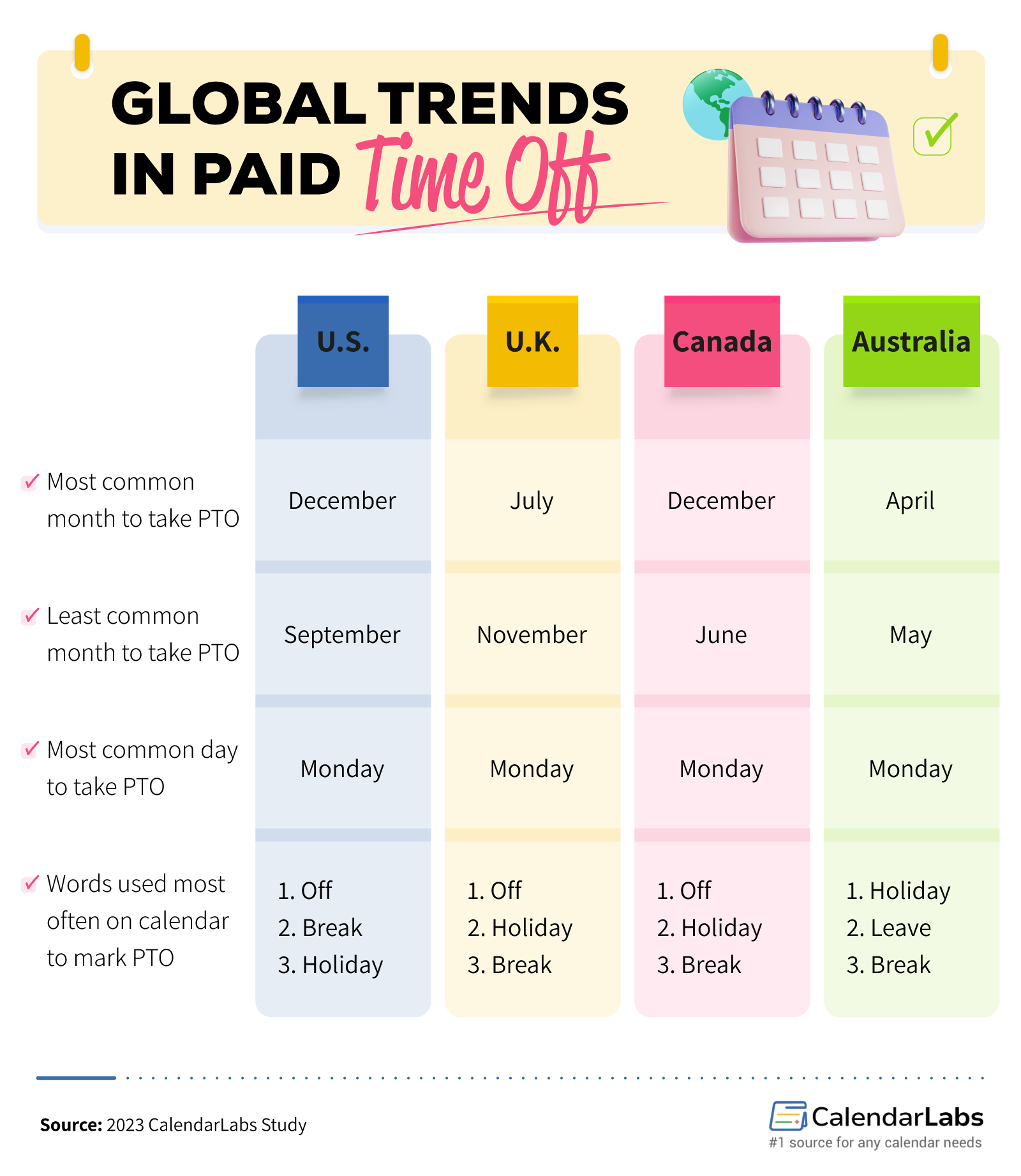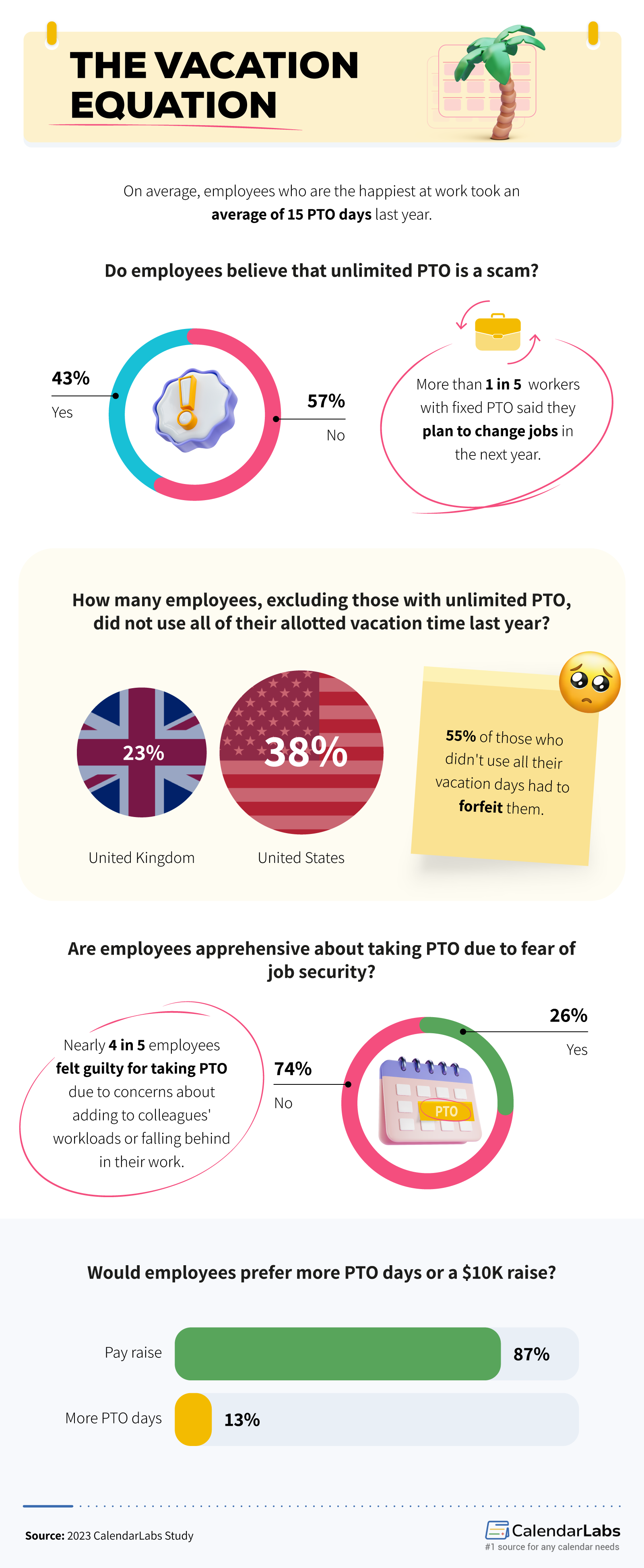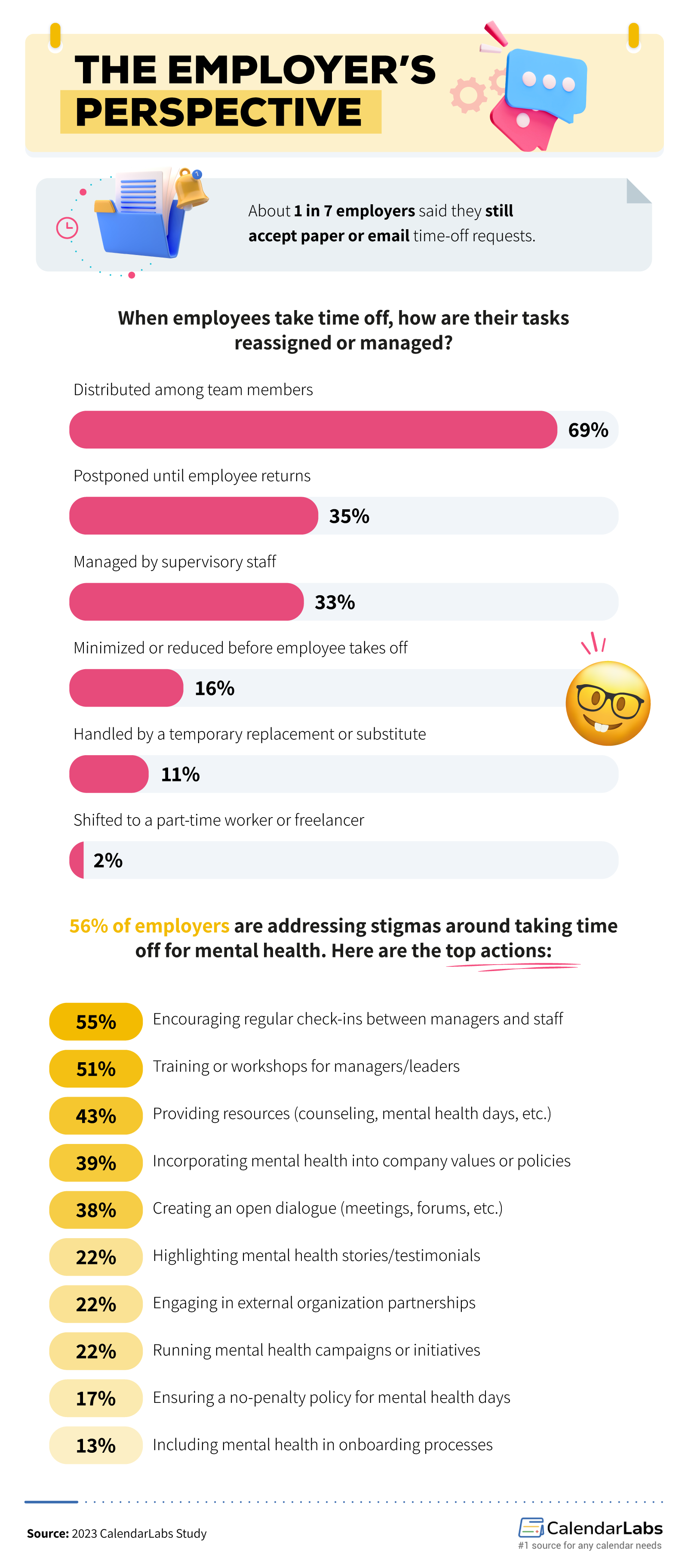
The Time Off Report
In an era where work-life balance is more important than ever, many people are curious about how paid time off (PTO) plays a role in employee well-being and organizational efficiency. What patterns might emerge if we explored the PTO habits of today's workforce?
To find out, we created an extensive survey, reaching out to 812 full-time American and British employees and 200 employers primarily based in the U.K. Alongside this, we sifted through the insightful data archives of CalendarLabs. Join us as we unpack today's PTO trends and their effects on the modern working world.
Key Takeaways
- Americans tend to take the most time off in December, while U.K. residents take the most time in July.
- On average, employees who are the happiest at work took an average of 15 PTO days last year.
- Nearly 4 in 5 employees feel guilty about taking PTO.
- About 1 in 8 employees would take extra PTO instead of a $10,000 pay raise.
- Almost 3 in 5 employers are addressing stigmas about taking time off for mental health.
PTO Rhythms Around the World
Let's first explore PTO differences based on where people live, using internal data about four major countries as our guide.

We analyzed our internal data to identify the PTO rhythms of workers in the U.S., U.K., Canada, and Australia. When do people take time off, and what do they call it?
Overall, Mondays were everyone's preferred day for some respite, but their top months varied.
Americans and Canadians predominantly marked their calendars for extended breaks in December, likely due to the winter holidays. Across the pond in the U.K., Brits were flocking to summer destinations the most often, as they favored July for sunshine-filled time off. But the British were in full work mode in November and took the least PTO. And while it's spring in April in the northern hemisphere, it's autumn down under—and the time of year Australians were most likely to take PTO.
Our study also revealed the terms each nation employs in their calendars to signify their days of leisure, with "off" being the most common. "Holiday" and "break" were also popular, with Australians using "leave" on their calendars more often than the other three countries.
This diverse mix of data gives us a fascinating look at how people from different cultures juggle work and play.
Transatlantic Time Off Tendencies
Balancing work and leisure has always been a delicate dance. If you've ever wondered how full-time employees in the U.S. and U.K. navigate their PTO policies and days off, our next infographic offers some eye-opening insights.

Looking deeper into PTO policies among U.S. and U.K. full-time employees, we discovered the following:
- On average, employees who were the happiest at work took an average of 15 PTO days last year.
- Remote employees took an average of 14 PTO days last year, compared to on-site employees who took 15 days.
- Employees at micro-sized companies (1-9 employees) averaged 11 PTO days, while those at large companies (250 or more employees) took off 17 days.
- U.K. employees significantly outpaced their U.S. counterparts, taking double the PTO days—24 vs. 12 days, respectively, on average.
- Some people clearly need more time off, as about 1 in 8 employees would prefer extra PTO days over a substantial $10,000 salary bump.
- A significant 65% of employees believed they should receive additional compensation when shouldering the tasks of absent colleagues.
- Employees with unlimited PTO were more likely than those with fixed PTO to be concerned about job security when taking time off.
Nearly 4 in 5 employees (78%) also harbored feelings of guilt when taking time off. Perhaps that's why 66% put in extra hours before their leave to prevent their workload from being passed on, and 69% admitted to responding to notifications while officially on PTO. Remember, you work hard—there's nothing wrong with setting your calendar to "out of office" and truly taking the time to disconnect and recharge.
Leading the Charge: PTO and Mental Support
To conclude our exploration, we'll spotlight managerial strategies for redistributing tasks during employee PTO and examine the prevailing attitudes towards mental health-related breaks.

Handling employee time off and workflows can sometimes be tricky for supervisors. How do they manage it?
Some employers favored direct communication with employees about PTO (51%), while others preferred digital tools like human resources software (43%) and shared calendars or scheduling tools (25%). Astoundingly, about 1 in 7 employers still relied on the classic methods of paper or email requests for time off.
As for the absent employee's workload, we found that employers were most likely to redistribute their tasks among the remaining workers (69%). Surprisingly, around 1 in 3 employers postponed assignments until the employee's return or shouldered the extra burden and managed the work themselves.
Taking time off for your mental health is as important as using PTO for holidays and other leisure activities. As mental health becomes a paramount concern in today's workplace, almost 3 in 5 employers reported actively dismantling stigmas around taking PTO for mental well-being. These company leaders are championing mental health through regular manager-staff check-ins (55%), tailored training sessions for leadership (51%), and offering mental health resources like counseling or mental health days (43%).
Beyond the Breaks
Our exploration into paid time off trends reveals an interesting relationship between employees, their workplace, and the value they place on personal time. Cultural differences impact when and how workers take breaks, while feelings of guilt and concerns about workload redistribution challenge many. It's promising to see employers stepping up to address the importance of mental health and the necessity of genuine breaks for their staff.
Moving forward, organizations worldwide must continue examining and refining their policies, encouraging employees to use their PTO and ensuring they prioritize employee well-being and balance in the workplace.
Methodology
To investigate patterns in paid time off (PTO), we surveyed 812 full-time employees residing in the United States (75%) and the United Kingdom (25%). Additionally, we surveyed 200 employers, primarily based in the U.K. We also analyzed internal data from CalendarLabs for the U.S., U.K., Canada, and Australia.
About CalendarLabs
CalendarLabs is a pioneer in delivering innovative printable calendar solutions. Focusing on precision and adaptability, we cater to individuals and businesses, providing them with the tools to schedule, manage, and maximize their time efficiently.
Fair Use Statement
You're welcome to share our PTO insights for non-commercial purposes. We kindly request that you include a link to this page to ensure proper attribution and provide readers with access to the comprehensive data and context.
